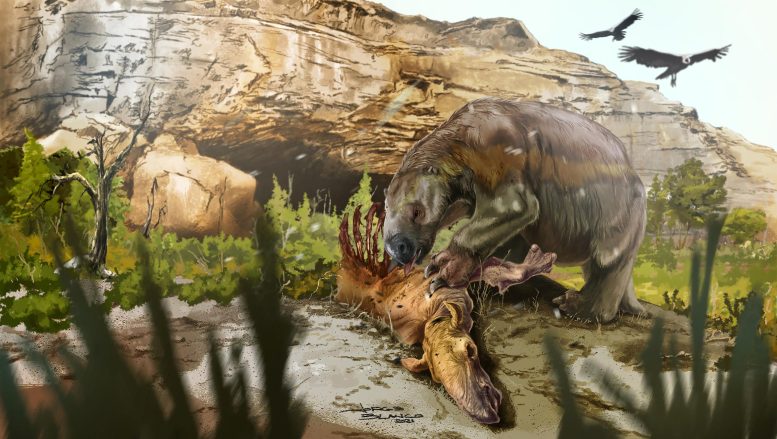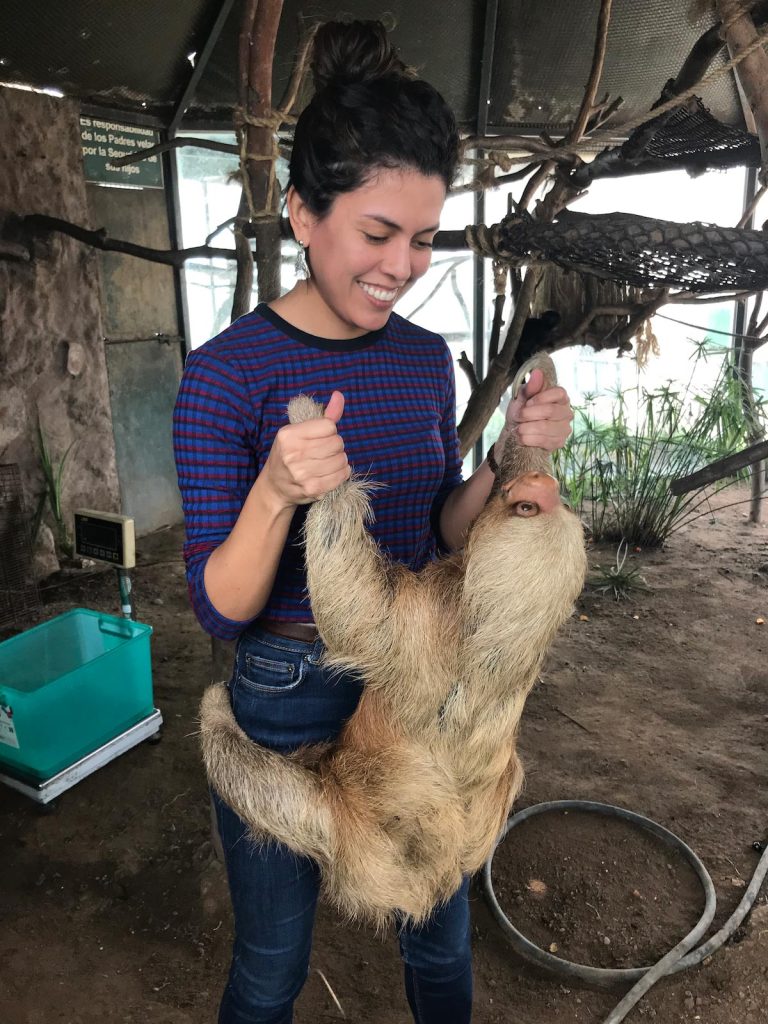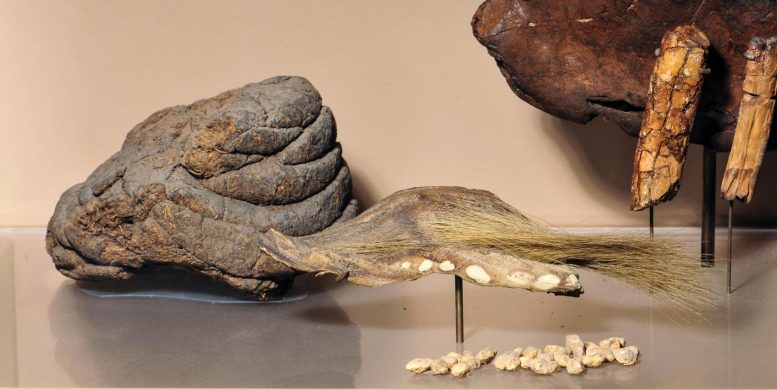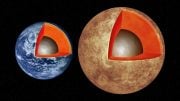
Reconstruction of the South American giant ground sloth Mylodon darwinii feeding on the carcass of the hoofed native herbivore Macrauchenia. These extinct mammals roamed the Pleistocene landscape of Patagonia and other parts of high and mid-latitude South America, like this reconstructed scene from about 12,000 years ago in front of the famous Mylodon Cave (Cueva del Milodón) in southern Chile. Credit: Artistic reconstruction by Jorge Blanco
New study reveals that Mylodon was an omnivore, unlike its strictly plant-eating relatives.
A new study led by researchers at the American Museum of Natural History suggests that Mylodon—a ground sloth that lived in South America until about 10,000 to 12,000 years ago—was not a strict vegetarian like all of its living relatives. Based on a chemical analysis of amino acids (fundamental biological compounds that are the building blocks of proteins) preserved in sloth hair, the researchers uncovered evidence that this gigantic extinct sloth was an omnivore, at times eating meat or other animal protein in addition to plant matter. The study, published today (October 7, 2021) in the journal Scientific Reports, contradicts previous assumptions in the field.

Lead author Julia Tejada with “Candy,” a three-toed sloth (Bradypus variegatus) at the Huachipa Zoo in Lima, Peru, one of six species of living sloths, all of which are strictly plant-eaters. Credit: © Carmen Capuñay
“Whether they were sporadic scavengers or opportunistic consumers of animal protein can’t be determined from our research, but we now have strong evidence contradicting the long-standing presumption that all sloths were obligate herbivores,” said lead author Julia Tejada, a Museum research associate and postdoctoral researcher at the University of Montpellier, France. Tejada began the work on this study as a Ph.D. student in the Museum’s Richard Gilder Graduate School collaborative program with Columbia University.
Even though the six living sloth species all are relatively small plant-eating tree-dwellers restricted to tropical forests of Central and South America, hundreds of fossil sloth species, some as large as an elephant, roamed ancient landscapes from Alaska to the southern tip of South America. Mylodon darwinii, also known as “Darwin’s ground sloth,” is thought to have weighed between 2,200 and 4,400 pounds (1,000 and 2,000 kilograms) and was nearly 10 feet long. Based on dental characteristics, jaw biomechanics, preserved excrement from some very recent fossil species, and the fact that all living sloths exclusively eat plants, Mylodon and its extinct relatives have long been presumed to be herbivores as well. But these factors could not directly reveal whether an animal might have ingested food that requires little or no preparation and is completely digested, as happens in carcass scavenging or some other kinds of meat-eating.
To get a more complete picture, the new study uses an innovative approach based on nitrogen isotopes locked into specific amino acids within animal body parts, known as “amino acid compound-specific isotope analysis.” Found in different proportions in the food consumed by an animal, stable nitrogen isotopes are also preserved in their body tissues—including hair and other keratinous tissues like fingernails, as well as in collagen like that found in teeth or bones. By first analyzing the amino-acid nitrogen values in a wide range of modern herbivores and omnivores to determine a clear signal of eating a mix of plant and animal food, fossils can then be measured to determine the food they consumed. This offers paleontologists a unique window directly into the diets of animals, enabling them to determine their “trophic level”—whether they were plant-eating herbivores, mixed-feeding omnivores, meat-eating carnivores, or specialized marine animal consumers.
“Prior methods relied solely on bulk analyses of nitrogen and complex formulas that have many untested or weakly supported assumptions. Our analytical approach and results show that many previous conclusions about tropic levels are poorly supported at best, or clearly wrong and misleading at worst,” said study co-author John Flynn, Frick Curator of Fossil Mammals in the Museum’s Division of Paleontology.

Skin and dung from the extinct giant ground sloth Mylodon darwinii on display at the American Museum of Natural History. Credit: © AMNH/D. Finnin
The researchers used samples from seven living and extinct species of sloths and anteaters (which are closely related to sloths), as well as from a wide range of modern omnivores, from the scientific collections of the Museum’s Mammalogy and Paleontology Departments and from the Yale Peabody Museum. While the other extinct sloth in the study, the North American ground sloth Nothrotheriops shastensis, was determined to be an exclusive herbivore, the data clearly flagged Mylodon as an omnivore.
Prior research speculated that there were more herbivores than could be supported by the available plants in ancient ecosystems of South America, suggesting that some of those herbivores may have been finding other sources of food. This new study provides compelling evidence supporting that previously untested idea.
“These results, providing the first direct evidence of omnivory in an ancient sloth species, demands reevaluation of the entire ecological structure of ancient mammalian communities in South America, as sloths represented a major component of these ecosystems across the past 34 million years,” Tejada said.
Reference: “Isotope data from amino acids indicate Darwin’s ground sloth was not an herbivore” by Julia V. Tejada, John J. Flynn, Ross MacPhee, Tamsin C. O’Connell, Thure E. Cerling, Lizette Bermudez, Carmen Capuñay, Natalie Wallsgrove and Brian N. Popp, 7 October 2021, Scientific Reports.
DOI: 10.1038/s41598-021-97996-9
Other authors on this study include Ross MacPhee, from the American Museum of Natural History; Tamsin O’Connell from the University of Cambridge; Thure Cerling from the University of Utah; Lizette Bermudez and Carmen Capuñay from the Huachipa Zoo in Lima, Peru; and Natalie Wallsgrove and Brian Popp from the University of Hawai’i at Manoa.
This work was funded by The Frick Fund (Vertebrate Paleontology, American Museum of Natural History), the Lamont Doherty Earth Observatory’s Chevron Student Initiative Fund, the Paleontological Society, and the School of Ocean and Earth Sciences of the University of Hawai’i at Manoa.









Sᴛᴀʀᴛ ᴡᴏʀᴋɪɴɢ ғʀᴏᴍ ʜᴏᴍᴇ! Gʀᴇᴀᴛ ᴊᴏʙ ғᴏʀ Ever, sᴛᴀʏ-ᴀᴛ-ʜᴏᴍᴇ ᴍᴏᴍs ᴏʀ ᴀɴʏᴏɴᴇ ɴᴇᴇᴅɪɴɢ ᴀɴ ᴇxᴛʀᴀ ɪɴᴄᴏᴍᴇ… Yᴏᴜ ᴏɴʟʏ ɴᴇᴇᴅ ᴀ ᴄᴏᴍᴘᴜᴛᴇʀ ᴀɴᴅ ᴀ ʀᴇʟɪᴀʙʟᴇ ɪɴᴛᴇʀɴᴇᴛ ᴄᴏɴɴᴇᴄᴛɪᴏɴ… Mᴀᴋᴇ $100 ʜᴏᴜʀʟʏ ᴀɴᴅ ᴜᴘ ᴛᴏ $13000 ᴀ ᴍᴏɴᴛʜ ʙʏ ғᴏʟʟᴏᴡɪɴɢ connection ᴀᴛ ᴛʜᴇ ʙᴏᴛᴛᴏᴍ .Yᴏᴜ ᴄᴀɴ ʜᴀᴠᴇ ʏᴏᴜʀ ғɪʀsᴛ ᴄʜᴇᴄᴋ ʙʏ ᴛʜᴇ ᴇɴᴅ ᴏғ ᴛʜɪs ᴡᴇᴇᴋ………….► 𝐖𝐰𝐰.𝐄𝐱𝐭𝐫𝐚𝐑𝐢𝐜𝐡𝟏.𝐜𝐨𝐦